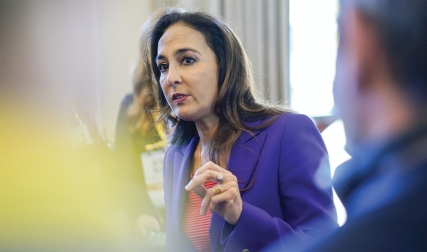State of the Art
The new Hood Museum of Art (“The Art of Curation,” March/April) is beautiful, and no doubt its exhibit spaces are state-of-the-art. But $50 million seems an exorbitant amount to spend for “six new galleries and three large classrooms,” even more so at a time when the cost of a higher education is under attack and there are calls to tax wealthy colleges such as Dartmouth.
Bob Asbury ’70, DMS’71
Rochester, New York
The article about the $50-million museum transformation was very informative. I’m sure many will disagree, but it seems the money spent and the continuing cost to support a staff of 30 is excessive and might well have been spent elsewhere. According to the article, there are 6,000 student visits per year. Put another way, since there are slightly more than 6,500 students at Dartmouth, each student visits the museum almost once a year! All that makes for a pretty costly visit.
Peter Schenck ’54
Santa Barbara, California
A Special Issue
As an instructor in 1956-57 in “Great Issues,” John Sloan Dickey’s innovative, short-lived, senior year required program, I gave student journals the grades “Distinction,” “Pass,” or “Fail,” so I feel qualified to judge your effort (January/February) to capture the special character of Dartmouth’s first 250 years. I award you Distinction for an artful distillation of the College’s history that captures its essence seasoned with wit. Required reading!
John M. Morris ’53
Old Greenwich, Connecticut
While I would have included one or two different names in “The 25 Most Influential Alumni” list (January/February), the magazine did a fabulous job understanding the meaning of “influential.” DAM avoided naming familiar people in entertainment and politics. It also avoided publishing a list of successful bankers and business people, even though Dartmouth has benefitted from their largesse through the years. Lastly, DAM avoided the diversity quota trap, in which such a list closely aligns with today’s campus demographics. The Dartmouth of today is tripping over itself in the name of student and faculty diversity, but for its first 200 years, Dartmouth was all male and mostly white. We cannot change that, but we can recognize there has never been a shortage of alums who influenced Dartmouth and society. So good job and a great issue!
Frank Hermes ’65
Williamsburg, Virginia
Dartmouth is justly proud of Nobel Prize winners Owen Chamberlain ’41 and George Snell ’26, respectively, No. 8 and No. 15 in the top 25 list. The College should be equally proud of K. Barry Sharpless ’63, who won the Nobel Prize in Chemistry in 2001.
Lawrence Zalcman ’65
Jerusalem, Israel
I have long considered DAM outstanding. Through the years it has far surpassed other alumni magazines. The recent “Special Issue” is absolutely stunning. The downside of its success, however, is that it works against any attempt to sell alumni on a digital edition. I would read less of a digital edition than I would of a print edition, and I would miss the tactile connection to Dartmouth the magazine gives me. The magazine quite literally tempts me to pick it up.
Michael J. Tan Creti ’62
Omaha, Nebraska
Thank you for a fabulous sestercentennial issue. I eagerly looked forward to reading “Keep the Damn Women Out.” It’s a good piece, but there’s a glaring omission—no mention of female exchange students who paved the way for coeducation at Dartmouth. I am an adopted—and proud—member of the class of 1971. I spent a year at Dartmouth as an exchange student from a historically black college. My story and those of my sisters who dared to travel to Hanover and learned in Big Green’s hallowed halls ought to be touted as part of Dartmouth’s history.
Theresa Williams Bennett-Wilkes ’71
High Point, North Carolina
After years and years of the Big Green, the “Special Edition” cover was black. Dartmouth green would have been a much more elegant, appropriate color. The implications of black are negative, while Dartmouth green is welcoming and joyous. When I saw the black cover, I wondered who died.
Richard Hollerith ’47
Williamsburg, Virginia
I enjoyed “Dartmouth 2069.” It does, however, have one glaring omission—the effect of global warming on the College. Carbon dioxide levels are on track to reach 530 ppm in 2069, levels last seen 20 million years ago, when sea levels were 50 feet higher. These are my predictions for Dartmouth in 2069.
1. All terms are summer terms.
2. There are now only three Ivy League schools—Dartmouth, Princeton, and Cornell. Due to rising sea levels, Harvard, Brown, Yale, Columbia, and Penn are under water.
3. Harvard breaks ground on its new campus at the second College Grant. In 2068 Dartmouth sold the grant to the Crimson in exchange for its $2-trillion endowment.
4. Great demand for an Ivy League education persists. Dartmouth admits a freshman class of 10,000 students.
5. The crew team is disbanded, many of its members having been eaten by alligators in the Connecticut River.
6. Dartmouth’s dining halls serve an abundance of locally grown tropical fruit.
7. Hanover is a popular spring break destination for students from northern Canada.
Michael Moriarty ’75, DMS’79
Haydenville, Massachusetts
Fuelish Plan?
A projected expenditure to change Dartmouth’s heat and power source to another carbon-based system is being promoted (“Campus,” March/April). The proposed system will cause increased particulate pollution and significant CO2 emissions—hardly the improvement it is touted to be.
Bioenergy plants have been in New Hampshire for more than 30 years and still must be subsidized by rate payers. The wood chip supply for the proposed plant will require that at least 15 immense diesel trucks travel local roads every day. Technological advancements will probably provide an eventual solution for the College. Given the brain power at the Thayer School, couldn’t a reasonable alternative to a $200-million, short-term step be found?
Austin Eaton ’62, Tu’63
New London, New Hampshire
Do the Right Thing
In a letter to the Dartmouth community posted to Dartmouth’s website on December 12, 2018, President Phil Hanlon wrote: “I deeply regret that an environment existed on our campus that was so at odds with our values.” This sentence misses the point and cuts to the heart of the outrage against Dartmouth. That is not what Dartmouth and its president should regret. They should regret permitting three men to resign or retire from Dartmouth after revolting allegations against them had surfaced (even if they had yet to be confirmed by an internal investigation) rather than firing them immediately for cause.
This is not the first time Hanlon has released a carefully worded statement that sidesteps responsibility for the handling of the sexual assault cases. The December message promises reform. But reform can occur only when there is clear recognition and ownership of an underlying problem. The problem here is that Dartmouth and its president can’t bring themselves to admit they were truly, egregiously wrong. And even after such wrongs were revealed to the world, they can’t stand up and do the right thing.
Victoria Corder ’05
New York City
CORRECTION: The story on Basil O’Connor, class of 1912 (January/February), mistakenly reported his daughter’s cause of death. She died in 1961 from the effects of uterine cancer. We regret the error.



